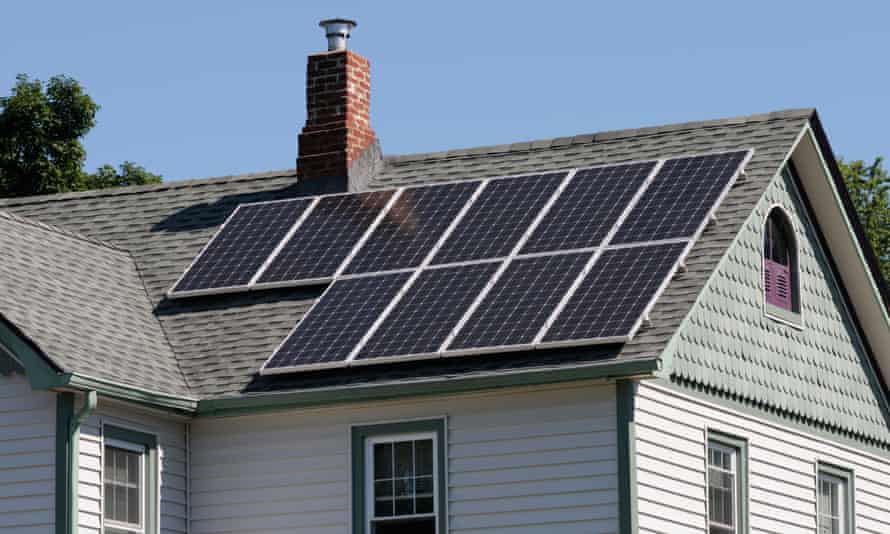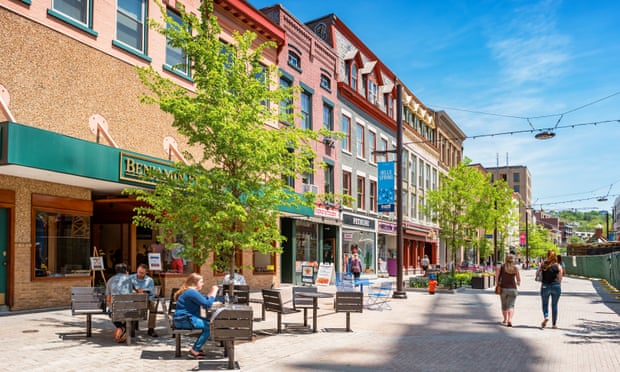But while that was an achievement on its own, said Schoeps, Ithaca can not address climate change one building at a time. “In order to move the needle, you’ve got to think in terms of a thousand [buildings],” he said.
Luis Aguirre-Torres, Ithaca’s new director of sustainability, is trying to do exactly that. The upstate New York city of 30,000, home to Cornell University and Ithaca College, adopted a Green New Deal in 2019, a big part of which involves decarbonizing thousands of privately owned commercial and residential buildings across the city.
Ithaca’s main climate objective is to eliminate or offset all of its carbon emissions by 2030. The focus on retrofitting buildings – installing electric heating systems, solar panels and battery storage as well as reducing energy use and greening the electric grid – promises to tackle an often-overlooked but significant contributor to climate change: buildings make up nearly 40% of US carbon emissions.
Building owners won’t make the transition from fossil-fuel energy all by themselves, said Aguirre-Torres, and state-funded incentive programs are often complex and sluggish.

So Ithaca is exploring a new solution to fund and motivate building owners to decarbonize: private equity.
Aguirre-Torres has helped Ithaca – which has a total budget of less than $80m – raise $100m by offering investors entry to a large-scale program he pitched as low risk with the potential for lots of cashflow. The goal is to create a lending program providing low- or no-interest loans and quick implementation of sustainable technology. The first batch of building owners could sign up as soon as September.
For most homeowners, the program would help them swap out a gas furnace for an electric heat pump, or a gas stove for an electric one – changes that would otherwise involve high upfront costs. Aguirre-Torres says the program will also train a new green workforce in Ithaca.
“We’re talking about a people-first approach, rather than just purely environmental,” Aguirre-Torres said. The plan aims to create 1,000 new jobs by 2030, and the city has promised to redirect 50% of the financial benefits of its Green New Deal plan to low-income residents, although there are few specifics on how this will work.
Conversations with investors started earlier this year. Covid-19 had already battered Ithaca’s finances, said Aguirre-Torres, and it was clear the city would never be able to fund this energy transformation alone.
These discussions quickly revealed a problem: how do you keep a lending program affordable? “What we needed to do was bring down the cost of capital even further,” Aguirre-Torres said.
The city is addressing this by trying to reduce risk. It aims to create an economy of scale by sizing the program for 1,000 commercial and residential buildings in the first 1,000 days, which will mean more consistent work for contractors and lower material costs. Ithaca plans to use a $10m loan loss reserve, backed by New York state, that would act as a guarantee for lenders in case any borrower defaults. It will also secure insurance to protect against “catastrophic losses”, such as a massive default due to another pandemic, Aguirre-Torres said.
Taken together, this means that money will be offered to building owners as low- or no-interest loans paid back by utility bill savings, and could even come with cash incentives. Because the loans will be backed by the city, low-income families can participate, even though their credit history might disqualify them for private loans.
Ithaca’s reliance on private equity may be new, but the cash incentives and on-bill repayment programs have precedent in states around the country, such as New York and California.
“We’ve seen this work,” said Ethan Elkind, the director of the climate program at UC Berkeley’s Center for Law, Energy & the Environment. Utilities and municipalities have long been offering upfront dollars to ratepayers to encourage them to upgrade lightbulbs or home insulation.
However, these types of improvements may be an easier sell than swapping out a gas range or fireplace. Consumer preference for natural gas appliances is one of the biggest barriers to home electrification. Cost is another. “If you have the money to do something to your house, putting in a new bathroom or kitchen is much more appealing to people than an invisible efficiency upgrade that pays for itself over eight years,” Elkind said.
Anne Rhodes has a different view, however. The 76-year-old Ithaca homeowner, who earns about $20,000 a year, is using an existing state incentive program to insulate her home and replace her oil heating system with electric heat pumps. In addition to the climate impact, she said the upgrades will make her home more comfortable to live in. “That’s going to be enormous, that’s going to make a huge difference,” she said.
Ithaca’s path could be a model for other cities, Elkind said, most of which have not figured out how to decarbonize buildings at scale. But there are a few caveats. The system only works in places with a municipally owned utility that allows for repaying the loans via bill savings. And whether those savings even exist depends on the rates for gas and electricity in a given market – in some cases, the cost of drastically increasing a home’s electricity usage could outweigh any reduction in gas costs.
Ultimately voluntary schemes will never lead to full decarbonization, Elkind said. “We need to move to a mandate, but let’s start with the incentives and the marketing,” he said. California is one state headed in this direction. It recently approved a plan to require solar panels and battery storage in many types of new construction.
In Ithaca, there are still challenges to overcome. Because it’s a college town, many buildings are owned by absentee landlords that will be hard to reach. Plus, even for local owners, clearly communicating a relatively complex funding structure may be difficult, Aguirre-Torres said.
But he sees this new strategy as a critical piece of the city’s plan to address climate change, which he said cannot be accomplished without making sure everyone benefits. Rhodes agrees: “There’s no way we’re going to meet our goals for the climate crisis if we don’t help low-income people”.







